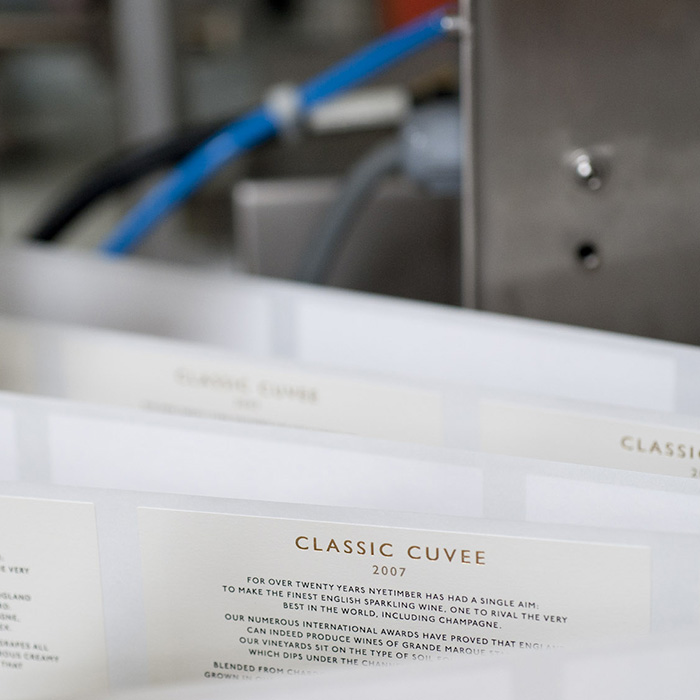Notes from the vineyard: labelling
Author: Guest Blogger

In the vineyard, we’ve recently passed through a stage of the growing season called “bunch closure”. We are very thankful for the incredible spell of warm weather that we’ve had in the south of England this summer. Despite a slow start to the year, bunch closure is occurring more or less in line with the long-term average at Nyetimber. As the name suggests, this stage is where the nascent berries swell to the point that adjacent berries touch one another (the bunch becomes “closed”). At this time of year, there aren’t otherwise many visible changes to the vines. Grapes will remain small and green until véraison (when the grapes change colour, early September for us) and the canopies are already full to the top wire, so bunch closure is one of the few milestones that we can use to gauge progress. However, beyond marking time, it doesn’t have great significance as an indicator of the growing season.
In the winery, August is our final month to look after some routine jobs before harvest preparations start to take place. In fact, some early preparations are already underway, but for the most part our time is occupied with activities like labelling. Labelling is a rarely discussed and often underappreciated part of the winemaking process. By the time labels are applied, there isn’t anything more that can be done on the wine quality front – bottles are now sealed and our contribution to the bottle ageing in our cellar is complete. Nevertheless, it’s a part of the process that gets our fullest attention because it’s the visible aspects of the bottle, not the wine inside, that often forms the first impression. Irrespective of the beautiful packaging design, or the wine inside, if the bottle arrives on the dining table with the label askew or poorly aligned, then we are starting on the back foot.
With sparkling wine, labelling is particularly challenging. This is because once the foil is applied over the cork and pleated, the bottle then has a definite “front” and “back”. With still wine, the cylindrical capsule rarely has markings to orient the direction of label, meaning the main body labels can go on in any place. But with sparkling wine we need to ensure that the neck label (“cordon”) aligns with the pleats of the foil, and of course the front and back labels need to align with the neck label and foil too. Other parameters to control are the spacing between front and back labels, and height that they are applied (imagine a retail display with bottles lined up horizontally – there should be consistency across all bottles).
I realise that none of these points are sexy, and it’s certainly not what compels young students to enrol in oenology. But, as a winemaker, the packaging step is one to overlook at your own risk. I’m not talking about the aesthetic aspects of label design, where individual taste most definitely plays a role, but rather how well the labels are applied to the bottle. This is an example where judging a book by its cover has some merit – in this case the “cover” gives us an indication of the attention to detail that is applied, and therefore the care with which that wine was handled. How well labels are applied isn’t a question of resource. Whether labels are basic or sophisticated, labels can be carefully and thoughtfully applied, even with rudimentary means and methods.
Although it’s never my primary criteria, the care with which the packaging is applied is certainly something I watch for in wine shops, so you can understand why we give labelling just as much attention. Next month, we’ll be back in the vineyard, as the grapes undergo véraison, and we start preparing in earnest for the harvest.
Read our full series following life at Nyetimber here or find out more about the wines on bbr.com.



Hi. just out of interest, do you apply the labels by hand or by machine?
Hi Ronnie. We use both methods, although our labels are primarily applied by machine. In my opinion, labelling (like riddling) is not a process where ‘by hand’ adds any special value or quality compared to using a machine…
Best Regards,
Brad